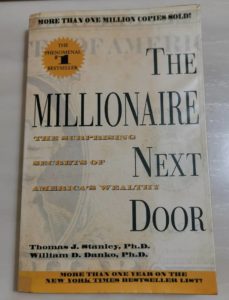A remarkable book by Thomas J. Stanley and William D. Danko
- Updated: November 12, 2020

The book The Millionaire Next Door: The Surprising Secrets of America’s Wealthy is a compilation of research done by Thomas J. Stanley and William D. Danko in the profiles of ‘millionaires’. The term ‘millionaire’ denotes U.S. households with net-worth exceeding one million dollars (USD).
I first heard of this book from a personal finance article in a magazine. It was one of the highly recommended self-help books related to financial independence and wealth management.
There and then, I decided to have a go at this book and ordered the 1996 paperback edition from Amazon. It arrived (with a few other books I ordered) after a several weeks and I dived straight into it.
Core message
The core message of the book is excellent and full of insight. I am sure that the principles in the Millionaire Next Door apply worldwide even though the research and findings are based on data from U.S. households.
Although the information in the book appears painfully obvious, but people in general hold similar views about wealth.
The millionaires that the book discusses are not the high spending people that we might imagine. The central premise of The Millionaire Next Door is that there is a surprising amount of quiet wealth accumulated by regular people, people who use this wealth to form a secure safety net for their families during hard times or to create a comfortable, worry-free retirement.
Many people believe “wealthy” and “high-income” are synonymous. Yet, surprisingly, many high-income earners are not wealthy. Even though they earn a lot of money, they do not keep much of it. People become wealth by increasing net worth through collecting appreciating assets and not by accumulating material possessions.
One of the most interesting things I learnt was that most millionaires got their wealth through self-employment. It is not fame, inheritance, high salaries, or any of the more common things we have been led to believe by the media and entertainment industry.
The message that wealthy people live among us, and we should live below our means is constantly driven home.it helps us understand what it means to be wealthy.
Wealth accumulators
The authors split everyone into two categories: Under Accumulators of Wealth (UAWs) and Prodigious Accumulators of Wealth (PAWs). UAWs have a low net worth relative to income, and the opposite for PAWs.
Their main argument is that PAWs get to be wealthy by living well below their means. PAWS are people who we think do not look like millionaires. They live in modest neighbourhoods, drive local cars, and usually have a blue-collar job. This will not steer them to an expensive lifestyle and as a result lead them to accumulate wealth.
On the other hand, UAWs are typically well-educated professionals with high income and high-profile jobs. However, their social standing brings them societal pressures that will push them to spend their money living in luxury neighbourhoods, drive expensive cars, and send their children to private schools. Their lifestyle will lead to them spending most of their income and result in a lower net worth.
Key takeaways
1. Many millionaires are first-generation
Most of the millionaires are “self-made”. Generational advantages may have played a role, but there are stories of people whose families were not wealthy and who still accumulated $1 million in savings or investments in a single lifetime.
First generation millionaires tend to be succeeded by children with financial struggles, since the parent’s desire to “give them a better life” pushes them into careers where they become UAWs, and their upbringing in our consumerist culture impedes their ability to live frugally.
2. A large percentage of millionaires are self-employed business owners
The authors write: “These self-employed people are four times more likely to be millionaires than those who work for others.” Two-thirds of the non-retired millionaires, them were small business owners.
They also tend to run their personal finances like their business finances.
3. Many millionaires are frugal and reject status symbols whenever possible
The book states that millionaires “believe that financial independence is more important than displaying high social status.” We must consider what we need and want when buying rather than let social pressures influence us.
Very few millionaires have ever spent much money on a nice suit, pair of shoes, or luxury watch. They usually live in modest neighbourhoods or rural areas where the cost of living is lower.
4. Millionaires spend time on their financial plans
Many millionaires spend time on planning for their financial future. Only the very high-income earners or those who inherited their money were less likely to plan for their financial future.
Buying income generating assets with income surplus or savings is a major part of the plan.
5. It takes time to become a millionaire
Many of the millionaires in the book were in their 50s or 60s. They have taken many years to do it.
We will require patience and discipline in managing our spending. Just spend less than what we earn. Most of the amounts saved will then be set aside to build a fund for buying income generating assets.
Summary
This book has encountered some criticism since its release in 1996. Criticisms include bias in the sample of millionaires and a lack of discussion of luck. Many people who have trouble in building wealth also drive cheaper cars and live in inexpensive neighbourhoods. Luck in business could also account for the difference in wealth.
The criticisms may well be valid, but the core values obtained from this book are true to me.
The message I am getting is that people who live below their means and work hard and set aside the cultural expectations of their spending to buy only what they want and need, can be millionaires.
They work hard, save, invest, spend wisely, and do not bother with keeping up with the Joneses. Alternatively, the people we tend to think of as rich or wealthy the ones who may likely be living from paycheck to paycheck.
The book was an eye opener for me when I first read it. It pointed the way forward for me in my effort in striving to achieve financial independence.
